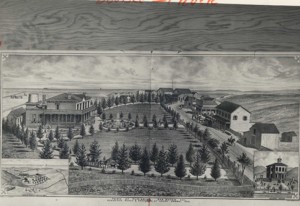Purisima, The Town That Could Have Been Half Moon Bay: Part I
 (Town of Purisima, circa 1870s, as depicted in the book, “The Illustrated History of San Mateo County,” Moore & DePue, publishers [1878]; reissued by Gilbert Richards Productions, Woodside, California in 1974)
(Town of Purisima, circa 1870s, as depicted in the book, “The Illustrated History of San Mateo County,” Moore & DePue, publishers [1878]; reissued by Gilbert Richards Productions, Woodside, California in 1974)
Click on the image to get a bigger picture!
By June Morrall
[I wrote this in 1977, using resources at the San Mateo County History Museum, Redwood City County Courthouse.]
As the first Americans reached “La Costa,” [the coast] in 1853, some purchased land, some lived a simple existence on rented soil–and still others, called “squatters,” ignored the formal rules of land ownership.
When a group of these squatters descended upon the Rancho Miramontes in Half Moon Bay on Sept. 24, 1853, they found Mr. Miramontes’ friends waiting to run them off the land. Unable to defend themselves in the face of strong opposition, the squatters drove off to drum up support.
And–soon, the Americans returned with reinforcements, boosting their number to 40 or 50. During the heated confrontation, the squatters, who caught the Spanish off guard, managed to seize even more land than before. [But, apparently, their victory was short-lived.]
Within a year, some of these Americans–sensing confusion over a narrow strip of disputed land, located between the Canada Verde and Purisima Creek, headed straight for the controversial territory. Merchants, who dreamed of developing a prosperous business district on the north side of Purisima Creek, followed behind.
And in this magnificent rural setting, four miles south of Half Moon Bay, the new village of Purisima rivalled Spanishtown.
But these early Americans soon learned they were not the first to settle beside the trout filled stream. Reports that nearly 80 years earlier, the Spanish explorer, Rivera, camped at Purisima Creek–meeting many of the Indians from the nearby village of ‘Shalaihme’–reached their ears. And there were stories that about 1776, the missionaries from San Francisco named Purisima, meaning something like “the place of the Purna,” the most pure or immaculate.
One of the first things the settlers did was to construct a schoolhouse, one of the first on the Coastside. According to legend, the school enrolled so many belligerent characters that the more good-natured citizens started the nearby Tunis School.
The beauty of Purisima, and the spectacular flora and fauna of the canyon, lured a steady stream of horse-and-buggy tourists to the new destination south of Spanishtown–where early spa entrepreneur Benjamin Lathrop opened the “Purissomo White Sulphur Springs” in 1856. Lathrop’s place, a combination mineral springs & ranch, and a five-hour ride from San Francisco, stood three miles from Purissima Falls, the village’s local wonder and curiosity piece.
The springs were of medicinal quality, Lathrop said, unsurpassed in the Golden State. He constructed a three-story hotel & resort, called it the Sulphur Springs Hotel, added a cottage and stables, all surrounded by forest and pasture land.
While Benjamin Lathrop must have been looking forward to a long stay, in the early 1860s he suddenly offered the 800-acre property for sale. The asking price: $16,000, “a fair price for the value of the land alone.”
[The Sulphur Springs Hotel was sold and rebuilt several times before being torn down.]
Apparently Purssima was large enough to warrant a post office, and the postmistress Mary Buzzel ran a place called the Purissima House, which I assume was a different place than the Sulphur Springs Hotel. The Purissima House stood “100 rods from the beach,” where tourists enjoyed abundant fishing, hunting and sea-bathing.
It was here that guests like the editor of the San Mateo County Gazette, described an “iron spring” on the trail leading to the spectacular falls.
As tourism flourished, the German farmer John Butts purchased more than 500 fertile acres and won awards as the best farmer in the county. He was joined by Irish families who settled on what they called “Irish Ridge,” gaining fame for their Coastside potatoes. The Portuguese specialty was horsebeans and the Italians knew everything about peas, sprouts, cauliflower, cabbages—and, of course, artichokes.
San Francisco Supervisor Nathaniel B. Lane bought 1000 acres, including a sawmill, powered by a waterwheel. Lane helped build a blacksmith shop across the way from Mary Buzzell’s hotel.
But, when, in early 1862 heavy rains caused Purisima creek to overflow, flooding the valley, and gulping down several acres of land, the Lane family, who had just built a new home, barely escaped with their lives. In fact, they watched their home float away.
The watery disaster took down redwood trees, some hundreds of feet tall and eight feet in diameter. And when the rush of water could no longer be heard, only the Nathaniel Lane’s piano lay undisturbed, high atop a redwood log, not far from where the family home once stood.
Crude roads and bridges were washed away, along with the debris of ranches, orchards, fences, as well as the redwood trees—all tumbling over the falls of Purissima into the sea.
Sadly, Nathaniel Lane himself passed away as a result of the trauma and exposure to the sudden vicious flood.
